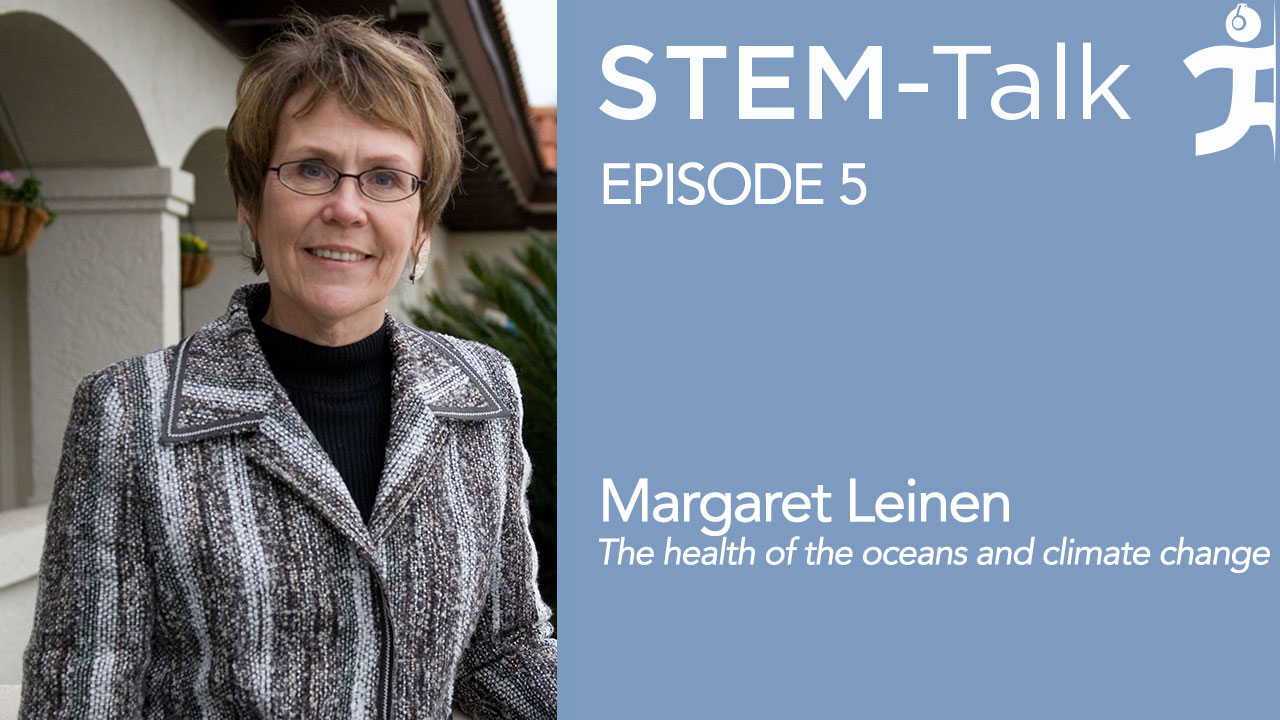STEM-Talk
Episode 5: Margaret Leinen discusses health of the oceans
// Mar 29, 2016

Margaret Leinen is a big name in oceanography. She’s the director of the Scripps Oceanographic Institute and vice chancellor of marine sciences at Scripps. She was previously assistant direct of the National Science Foundation, where she worked with IHMC CEO and Director Ken Ford, who calls her “one of the most effective and most pleasant assistant directors of NSF.”
Leinen’s interest in science started early: In high school, she became interested in geology and the history of the earth. When she discovered oceanography in college, she never looked back.
In this episode, Leinen talks about her first dive in the Pacific, where she stumbled onto a huge hydrothermal vent system teeming with worms, clams and other colorful life forms. She also addresses current and future threats to the ocean, a non profit she established to look into mitigating the effects of climate change, and the overall resilience of the oceans.
Host Dawn Kernagis, whose own interest in becoming a scientist—started with her childhood fascination with the ocean—conducts this interview.
3:00: In 2000, NSF director Rita Colwell asked Leinen to come to D.C. to talk to her about working at NSF to coordinate environmental science, engineering and education across entire foundation.
5:32. Leinen says a theme of her career has been cross disciplinary coordination. “I think it takes an optimist, and that’s me, I’m definitely a glass is half full kind of person.”
6:28: “People want to be able to cross boundaries, and most of the time they think that they do, but organizations put obstacles in front of them. My job is to find out what the obstacles are and then embrace them.”
9:10: Leinen talks about her role as director of Scripps, the oldest institute for oceanography, which just celebrated its 114th birthday.
10:00: Scripps has programs with University of California-San Diego medical and pharmacy schools. The oceans influence human health—and “Not just safety of seafood, red tides, or harmful algal blooms.”
10:24: “When you take a big breath of that wonderful salt air, you’re also inhaling thousands of viruses and bacteria from the ocean.” That may be harmful, or it may confer immunity.
11:57: We’ve gone beyond detecting climate change and attributing it to what is natural or human-induced; and we are now interested in how it impacts humans, the land and oceans—and how we must adapt.”
12:34: Understanding all these threads is “deeply inter-disciplinary.”
13:34: Leinen talks about the non-profit she started, the Climate Response Fund, to research “climate engineering,” or mitigating climate change.
17:15: The Climate Response Fund was a group of scientists and policy experts working with the public, governmental groups, non-profits and scientific groups. “It was a facilitator of discussions.”
18:00: In the U.S., research agencies have been reluctant to fund research in climate engineering, both because of the lack of a good policy framework as well as the potential pubic response. European groups have also struggled.
20:58: Leinen describes her early interest in geology as a high school student. Later, in college, “I just got seduced by oceanography.”
23:05: Leinen talks about the Joint Global Ocean Flux Study (JGOFS), which looked at the carbon cycle in the ocean: “The ocean’s role in really the thing that keep the planet alive.”
24:13: The Equitorial Pacific extends across half the planet. “It’s very, very productive,” but that depends on whether it’s an El Nino time or not.
25:05: During normal (non El Nino) times, there is “An upwelling of deep waters,” and the breakdown of organic material by microbes. “During an El Nino this is limited, [the ocean] is not as biologically productive.”
26:50: JGOFS involved nine different two-month long cruises from the U.S. team, with 70 major scientists and their respective teams. There were other teams from Japan, Australia, New Zealand, Ecuador, Chile.
33:00: Leinen describes her first Alvin dive (three-person submersible), in an area off Washington State.
36:00: There he found a huge hydrothermal system, covered with worms and clams and spewing hot water. “My very first Alvin dive landed in the middle of one of the largest hydrothermal vent systems that we’ve ever seen.”
41:43: “I think the biggest threat to the ocean is our ignorance of it.” Some of the biggest threats include acidification, sea level rise, and the warming of the ocean.
45:28: The ocean is “a lot more resilient than we thought.” Coral reefs, for example, are not as endangered as they are perceived to be.
47:00: “The oceans aren’t going to die. We will be powerfully impacted. But they have been through a lot, and there’s a great genetic treasure trove of resilience built into marine organisms over these billions of years of evolution.”
48:12: The problem is the pace at which we are acidifying the ocean. Oceans have previously been acidic—but over tens to hundreds of thousands of years. “We don’t know how resilient things are to rapid change.”
49:18: PH is a measure of the hydrogen iron content of something. It’s hard to measure in the ocean because there are so many different kinds of acids; stable measuring instruments are also lacking.
52:30: Scripps is the home of instrument standards and instrument development for oceanography and related topics.
54:54: Dawn mentions that Pensacola and other coastal cities have a lot of run-off to the ocean, from petroleum and other sources promoting phosphate growth. Leinen comments that this non-point-source runoff results in enhanced growth of algae and phytoplankton and other plants in the ocean.
59:57: “The history of women in science over the last fifty years is really an extraordinarily good news story.”
1:01:00: Leinen notes that some fields, such as biology, have more women than men at the undergraduate level, but not necessarily in faculty/leadership positions. But the geosciences still have more men than women, producing even more of a gender gap than math or physics.
1:03:50: Lack of exposure partially drives imbalance of students in geosciences. “You would be amazed at how many children in San Diego have never been to the beach…. It’s the same in Florida, Virginia, Rhode Island.”
1:05:17: Leinen talks about her role models and mentors, making a distinction between the two. A mentor “takes an active role in your career…. Is an advocate.” A role model, she says, is someone “seen from afar.”
1:07:36: Ken Ford comments that Leinen has had a “terrific career” as a scientist, administrator and policy maker. “She’s impacted science in the U.S. and around the world.”






